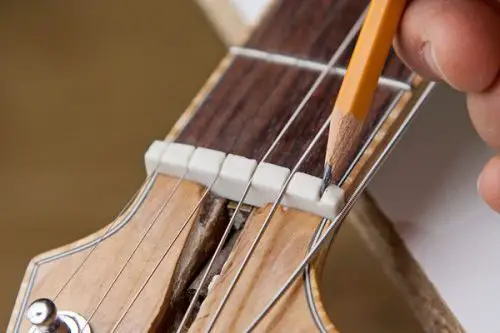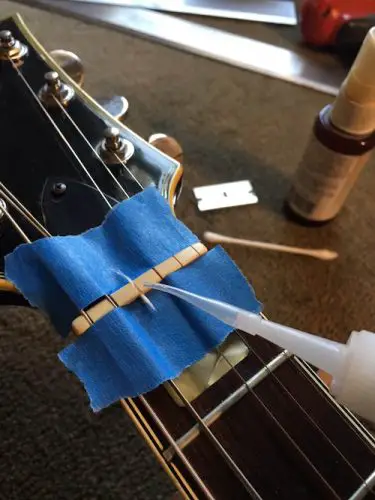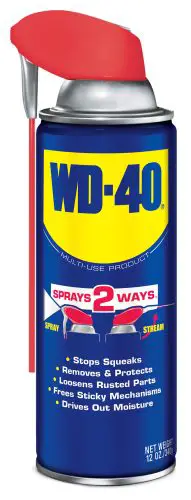When it comes to lubricating a guitar nut, there are several options available. One commonly used lubricant is graphite. Graphite is a dry lubricant that helps reduce friction between the strings and the nut, allowing for smoother tuning and improved string durability.
Applying graphite to the nut can be done by rubbing a pencil lead across the slots, or by using pre-made graphite lubricant in a tube or powder form. It is important to make sure that the graphite does not build up in the nut slots, as this can cause tuning issues.
Alternatively, lubricants such as petroleum jelly or silicone-based lubricants can also be used to lubricate a guitar nut. These lubricants provide a more slippery surface, which reduces friction and improves tuning stability. However, it is crucial to use these lubricants sparingly and avoid applying excessive amounts, as they can attract dust and debris, leading to potential problems with string vibration.
Additionally, there are specialized guitar nut lubricants available in the market. These lubricants are designed specifically for the purpose of nut lubrication and usually come in the form of oils or gels. They provide a smooth and long-lasting lubrication without attracting dust or debris. These specialized lubricants are often the preferred option for professional guitar techs and players who require precise tuning stability, but they can be more expensive than other alternatives.
Here’s a summary that sums up the entire article if you are too busy. Otherwise, read till the end because there are much more to the topic!
| Question | Answer |
|---|---|
| What can I use to lubricate my guitar nut? | You can use graphite, petroleum jelly, silicone-based lubricants, or specialized guitar nut lubricants. |
| What does graphite in guitar nut do? | Graphite reduces friction between the strings and the nut, allowing for smoother tuning and improved string durability. |
| Is graphite good for guitar nuts? | Yes, graphite is commonly used and considered good for guitar nuts due to its dry and long-lasting lubrication. |
| How do you put graphite on a guitar nut? | You can rub a graphite pencil lead across the nut slots or use pre-made graphite lubricant in tube or powder form. |
| How often should I lubricate my guitar nut? | It is recommended to lubricate the guitar nut every few months or as needed based on signs of wear or decreased tuning stability. |
| Can I use WD-40 to lubricate my guitar nut? | While WD-40 can be used as a temporary solution, it is not recommended for long-term use due to potential drawbacks. |
| What are the signs of a dry guitar nut? | Signs of a dry guitar nut include increased friction when tuning, string binding, audible clicking sounds, dull appearance, and dirty nut slots. |
What does graphite in guitar nut do?

Graphite is a common choice for lubricating a guitar nut because of its dry and slippery properties. When applied to the nut slots, graphite helps reduce friction between the strings and the nut. This reduction in friction allows the strings to move more freely, resulting in smoother tuning and improved string durability.
The main purpose of using graphite in a guitar nut is to ensure that the strings slide smoothly through the nut slots, minimizing any binding or sticking that may occur.
When the strings bind in the nut slots, it can cause tuning issues, such as difficulty in staying in tune or strings that don’t return to pitch properly after using the tremolo bar. By lubricating the nut with graphite, the strings can easily glide through the slots, ensuring accurate and reliable tuning.
Graphite is an ideal choice for nut lubrication because it is a dry lubricant. Unlike oils or gels, graphite does not attract dust or debris, which can cause problems with string vibration and interfere with the tuning stability. This means that when graphite is applied correctly, it stays in place without gunking up the nut slots.
To apply graphite to a guitar nut, you can rub a pencil lead across the nut slots or use pre-made graphite lubricant in a tube or powder form. It is important to avoid excessive buildup of graphite in the nut slots as it can cause tuning issues. If you do notice a buildup of graphite powder in the nut slots, it is advisable to clean it out to maintain optimal performance.
Overall, using graphite in a guitar nut helps reduce friction, allowing for smoother tuning, improved string durability, and better overall performance. It is a common and cost-effective solution for players looking to enhance their guitar’s tuning stability.
Is graphite good for guitar nuts?

Graphite is commonly used and considered to be good for guitar nuts. Graphite, a dry lubricant, is preferred by many guitar players and technicians because of its ability to reduce friction between the strings and the nut, resulting in smoother tuning and improved string durability.
One of the reasons graphite is favored for guitar nuts is its dry nature. Unlike oils or gels, graphite does not attract dust or debris, which can negatively affect the vibration of the strings and cause tuning instability. This helps to keep the nut slots clean and free from any build-up that may interfere with proper string movement.
Graphite also offers a long-lasting lubrication effect. Once applied, it remains in the nut slots for an extended period, reducing the need for frequent reapplication. This is particularly beneficial for guitarists who play regularly and need consistent tuning stability throughout their performances or practice sessions.
Another advantage of using graphite for guitar nuts is its affordability and accessibility. Graphite can be easily found in the form of pencil lead or pre-made lubricants in tubes or powder. This makes it a cost-effective choice for players who want to improve their guitar’s tuning stability without breaking the bank.
That being said, it is important to note that while graphite is generally considered good for guitar nuts, it may not be suitable for all situations. Some players may prefer the use of specialized guitar nut lubricants which are specifically formulated for optimum performance. These lubricants often come in the form of oils or gels and offer different properties that may cater to specific playing styles or preferences.
Also Read: Do Bone Nuts Sound Better? (Advantages & Tone Difference )
How do you put graphite on a guitar nut?
Applying graphite to a guitar nut is a relatively simple process. There are a few different methods you can use to put graphite on a guitar nut, depending on the form of graphite you have available.

If you are using a graphite pencil, start by removing the strings from the guitar or loosening them enough to access the nut slots. Take the pencil and lightly rub the graphite lead back and forth across the nut slots. The graphite will leave a thin layer of lubricant on the nut, providing smoother string movement.
Be careful not to press too hard, as excessive graphite can build up and cause tuning issues. Once you have applied the graphite, clean off any excess with a soft cloth or brush.

Alternatively, if you have pre-made graphite lubricant in the form of a tube or powder, you can use a small brush or toothpick to apply it to the nut slots. Gently brush the lubricant into each slot, making sure to cover the entire area. Use a minimal amount of graphite to avoid buildup and potential problems with tuning stability.
When applying graphite to a guitar nut, it is essential to be cautious and avoid getting the lubricant on other parts of the guitar, such as the fretboard or finish. Graphite can be difficult to clean off these surfaces and may cause damage or discoloration.
It’s worth mentioning that some specialized graphite lubricants come in applicator pens or squeeze bottles with a fine tip. These tools make it easier to target specific areas and control the amount of graphite being applied. If you prefer a more precise application, these types of lubricants can be a convenient choice.
How often should I lubricate my guitar nut?
The frequency of lubricating a guitar nut depends on several factors such as the type of lubricant used, playing style, and environmental conditions. As a general guideline, it is recommended to lubricate the guitar nut every few months or when you notice a decrease in tuning stability or increased friction when tuning.
Regularly inspecting the nut is crucial in determining when it needs lubrication. If you see signs of string binding or resistance when tuning, it is a good indication that it may be time to lubricate the nut. Additionally, if you live in a particularly dry or humid climate, you may need to lubricate the nut more frequently to combat the effects of these conditions on the guitar’s playability.
It’s important to note that excessive lubrication can be just as problematic as not lubricating at all. Overusing lubricant can cause a buildup of residue in the nut slots, resulting in poor string sustain, buzzing, or even problems with intonation. Therefore, it’s essential to find the right balance when lubricating the guitar nut.
Ultimately, it is best to rely on your own judgment and the specific needs of your guitar. Pay attention to any changes in how the strings feel when tuning and check for any signs of wear or binding. If you’re unsure, consulting with a professional guitar technician can provide valuable insights and guidance on the optimal frequency for lubricating the nut based on your guitar’s specific needs.
Can I use WD-40 to lubricate my guitar nut?

While it is possible to use WD-40 as a temporary solution to lubricate a guitar nut, it is generally not recommended for long-term use. WD-40 is primarily a penetrating oil and water displacement product, rather than a dedicated lubricant designed for musical instruments.
WD-40 can provide short-term lubrication and help reduce friction in the nut slots, but it has some potential drawbacks. Firstly, it is a wet lubricant, meaning it can attract dust and debris, which can lead to issues with string vibration and interfere with tuning stability. Additionally, the petroleum-based nature of WD-40 can potentially damage certain guitar finishes or plastics over time.
Moreover, WD-40 can dry out quickly, leaving behind a sticky residue that can further contribute to binding and tuning issues. This is especially true if it is not consistently reapplied, making it a less reliable option in terms of maintaining long-term lubrication.
While WD-40 may offer a quick fix in emergency situations or for very short-term use, it is advisable to seek out specialized guitar nut lubricants for optimal performance. These dedicated lubricants are specifically formulated for use on musical instruments and provide a dry lubrication that minimizes friction without attracting dust or causing damage.
If you find yourself in a situation where WD-40 is the only option available, it is important to use it sparingly and wipe off any excess after application. Be mindful of the potential drawbacks and consider investing in a proper guitar nut lubricant for regular use to ensure the best performance and longevity of your instrument.
What are the signs of a dry guitar nut?
There are several signs that can indicate a dry guitar nut. One common sign is increased friction when tuning the strings. If you notice that the strings are difficult to turn or feel like they’re sticking in the nut slots, it may be a sign that the nut is dry and in need of lubrication.
Here are 5 signs of dry guitar nut:
- Increased friction when tuning strings: When tuning, you might notice that the strings are harder to turn or seem to stick in the nut slots. This is due to the lack of lubrication in the nut, which can make tuning a challenge.
- String binding or sticking: A dry nut can cause the strings to become trapped or tightly held in the slots. As a result, they struggle to move freely or return to their correct pitch. This can lead to tuning instability, where the strings don’t stay in tune or experience pitch shifts after using the tremolo bar.
- Clicking/cracking sounds: If you hear clicking or cracking sounds when you’re tuning or bending strings, it’s a sign that the nut might be dry. Without proper lubrication, the strings can bind or catch in the nut slots, creating these audible noises as you manipulate the strings.
- Dull appearance: Visually, a dry guitar nut might look dull and lack any shine. The lack of lubrication can cause the nut material to dry out, losing its smoothness and luster over time.
- Dirty nut slots: Another visual indicator is the presence of dust or dirt in the nut slots. The absence of lubrication can make the nut slots more susceptible to collecting debris, affecting the overall performance and playability of the guitar.
Remember that a dry guitar nut doesn’t just impact how your guitar feels and sounds—it can also lead to increased string wear. The friction against the dry nut slots can cause strings to break prematurely or become damaged.
To prevent these issues, it’s crucial to regularly inspect your guitar nut and address any signs of dryness by applying a suitable lubricant, such as graphite or specialized guitar nut lubricants. By doing so, you can restore optimal performance and stability to your instrument and prolong its lifespan.
Summary
In conclusion, keeping your guitar nut properly lubricated is essential for maintaining tuning stability, improving string durability, and enhancing overall playability. Whether you choose to use graphite, specialized lubricants, or other alternative options, finding the right lubricant for your guitar is key.
Graphite is a popular choice due to its dry and long-lasting lubricating properties, while specialized guitar nut lubricants offer precision and reliability. Remember to use lubricants sparingly, avoid excessive buildup, and regularly clean the nut to ensure optimal performance.
While you may come across individuals suggesting unconventional solutions like WD-40, it’s best to stick to lubricants specifically designed for musical instruments to avoid any potential damage or long-term issues.
By understanding the benefits of proper nut lubrication and recognizing the signs of a dry nut, you can take proactive measures to keep your guitar in top shape. Experiment with different lubricants, listen to your instrument’s needs, and enjoy the smooth and harmonious journey of playing your well-lubricated guitar. Rock on!





